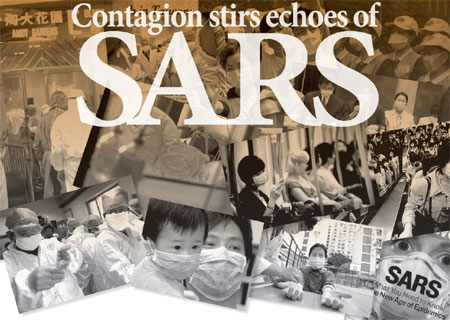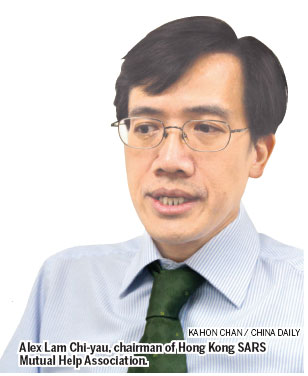Contagion stirs echoes of SARS
Updated: 2011-09-23 07:51
(HK Edition)
|
|||||||



As the Hollywood blockbuster Contagion spreads its tale of global pandemic, Kahon Chan recalls the very real terror that spread through Hong Kong and other parts of the world when the SARS epidemic of 2003 brought the city to its knees, psychologically and economically.
In 2003, Tony, who doesn't want his full name revealed, was still suffering the after effects of an on-the-job back injury three years earlier. He had suffered the injury while doing a blue collar job, working with interior fittings. The medication prescribed for him at the time left him with chronic respiratory problems - and proved the first link in a chain that led to a potentially life threatening encounter with SARS (severe acute respiratory syndrome).
Since taking the medication for his back pain, Tony had experienced frequent asthma attacks - finally reaching a degree of severity that required hospitalization, in March of 2003. During his confinement in hospital, he gave his consent to become the subject of a clinical lecture for a group of medical students. The encounter with the medical group, he believes, was the point at which he became exposed to the virus. Thereafter, Tony's condition took a serious turn for the worse, as he came down with a high fever and an infection that left his lungs extensively damaged. He required steroid treatments.
Tony became one of the 1,755 patients diagnosed with SARS between March and June of that year. Tony was one of the survivors, but before the mysterious outbreak was contained through extreme quarantine measures and an urgent public awareness campaign, 299 people had died.
Today, as one looks out onto Hong Kong's busy streets, it's hard to imagine what it was like back then - as people cowered in their homes, with an entire neighborhood cordoned off, conspiracy theories and fresh rumors every day, and Hong Kong International Airport and the hubs of Hong Kong's renowned vitality eerily deserted, all became marketable as entertainment.
All the fear and the harsh realities that spawned the film have been given an all-star cast, and packaged into the Hollywood blockbuster Contagion. The film took in over $22 million on its opening weekend, propelling it into a strong second week. In the end, the two-hour cinematic ordeal wraps up on time and movie-goers go home unscathed.
Tony's encounter with the SARS contagion however left indelible marks. Once a robust blue-collar worker, Tony returns home today to confront the difficult challenge of climbing the stairs to his residence. His lungs heave. His knees feel week. Constant, low levels of cortisol have left him weakened. Now in middle age, he had to quit his daytime job, started spending his savings and makes frequent visits to the hospital for follow-up consultation.
Time cannot heal these wounds. As Tony gets older, he begins to confront age-related problems.
"I used to be very muscular and a hospital worker said I was fortunate to have recovered. Look at my arm now, it has shrunk. All the pain is beyond words." Tony said.
Lives of many of the survivors of the SARS outbreak have been permanently affected. In some cases the virus appears to have triggered an over reaction of the body's immune system, potentially causing damage to other parts of the body. High doses of steroids and ribavirin were then prescribed in Hong Kong to bring the response under control.
The many side effects included avascular necrosis, a condition brought on by the adverse affects of prescription steroids, damaging bones and even joints. A survey of over 800 recovered patients in December 2003 found the syndrome among 14 percent of them. Some side effects however did not show up until later.
Lack of progress
Yuen Kwok-yung, chair of Infectious Diseases at the Department of Microbiology of the University of Hong Kong, agrees that SARS and other major outbreaks of the computer age have contributed to better research leading to identifying epidemic threats, for improving controls against the spread of infection, rapid diagnosis and vaccination.
Yuen, who lists himself as an early advocate of steroids treatment for SARS, however, is "sorry to say" that rapid and intense mobilization of resources that brought down the deadly virus quickly prevented science from identifying the optimal weapon, which could have defeated SARS with fewer side effects.
The World Health Organization requested a systematic evaluation of 71 clinical and laboratory studies on treatment effects of SARS in 2005, including those published in Chinese literature, to guide future research and treatment.
In 29 studies of prescription steroid use, 25 were ruled as inconclusive, four were judged as "causing harm". The 30 reports on ribavirin showed "no convincing evidence that it led to recovery" and four reports focused on the adverse affects. The review therefore was unable to reach any conclusion on an optimal treatment and called for more systematic trials of treatments when the SARS virus awakens again.
Lo Wing-lok, a specialist in Infectious Disease and a member of the Legislative Council during the SARS outbreak, acknowledges the limited choices of treatment and lack of information for decision makers in 2003. He also regretted that the need for evaluation of the hectic battle against the infection became overwhelmed by the media's portrayal of the heroes who contained the epidemic.
"It was sad that the Legislative Council spent 500 hours on the evaluation report and the attention from media only lasted less than two weeks. They were busy honoring their heroes."
Chan Pik-kwan, a mother of two who lost her husband to SARS, would easily be credited as one of the heroes - at least within her small circle. From a "happy housewife" who had no idea where to settle a gas bill, she dragged her weakened body out of the hospital and restored order to her crumbled family through the strength of her own hands.
Baptized in her hospital dormitory, she believed faith in God would maintain her strength through the ups and downs. "I have been very resilient in the eyes of my friends and family. I did not even drop a tear at my husband's funeral."
After quitting her stressful part-time housekeeping job, Chan went into social work. She enrolled in various courses that taught her about opening a business and handcrafts. Two years ago, as she was preparing to attend her elder daughter's university graduation, she came up with the idea that she wanted to learn to use Photoshop.
"Since I always thought a family photo must include my husband and he was gone, I hoped to have his face photoshopped to the graduation photo." She explained.
Resilience and depression
Meanwhile, she continues to take sleeping pills to deal with her insomnia. She's been going to a psychiatric clinic for the sole purpose of obtaining the prescription for sleeping pills. Other medical specialists denied her request. Still, her consultation with the psychiatrist brought a shocking revelation. Her doctor told Chan that she showed evidence of depression. The doctor pointed to Chan's obsession to photoshop the image of her deceased husband into a family photograph as an obvious clue.
She bridled when her psychiatrist forbade her from "missing" her beloved husband, but slowly realized her emotional response had not been quite proportional to the scale of the challenge she has tackled in the eight years since SARS.
"The unpleasant feelings were repressed and hidden in a 'locker'. But if I wanted to look into it on any day, it might overflow and lead to an emotional breakdown."
A year after her therapy began, she went to a screening of Contagion. She knows how hard it has been for those who recovered from SARS. "I knew a patient who did not look back for a second after being discharged from hospital, like he was freed from prison. He looked desperate to break the association (with SARS)."
Tony and Chan Pik-kwan are among the few who still associate themselves with the SARS ordeal. The Hong Kong SARS Mutual Help Association has about 300 members, about one fifth of those in the SAR who survived the disease. Association Chairman Alex Lam Chi-yau assumes the other survivors put the health issues behind that and have carried on with financially successful lives.
Some others, he believes, remain in denial about their past.
As a lawyer, an optimist and fully recovered patient with no side effect left behind, Lam was not immune to acts of discrimination. In 2006, a can of Sarsae cola was placed at this front door without any attached message. "I felt insulted even though the intent was unclear." He thought the probable intent was as a sarcastic gesture. "Maybe they would place pork belly for a fat neighbor."
As time goes by, Lam has seen patients lose their free healthcare benefits. The association has also been forced to make budget cuts. The chairman pledged the group would keep its promise to serve its members, but he added, he can't defy gravity.
"As the curve (of public concern) ran downwards, attention from the government and support from society have long abandoned us," he said.
(HK Edition 09/23/2011 page4)